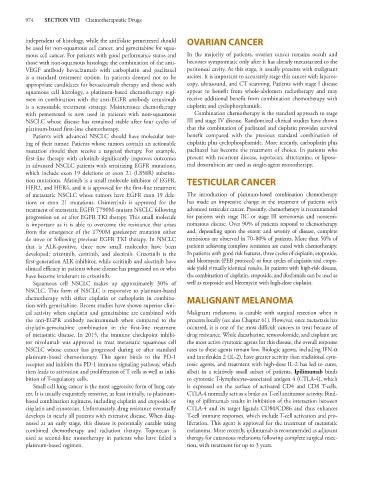Page 988 - Basic _ Clinical Pharmacology ( PDFDrive )
P. 988
974 SECTION VIII Chemotherapeutic Drugs
independent of histology, while the antifolate pemetrexed should OVARIAN CANCER
be used for non-squamous cell cancer, and gemcitabine for squa-
mous cell cancer. For patients with good performance status and In the majority of patients, ovarian cancer remains occult and
those with non-squamous histology, the combination of the anti- becomes symptomatic only after it has already metastasized to the
VEGF antibody bevacizumab with carboplatin and paclitaxel peritoneal cavity. At this stage, it usually presents with malignant
is a standard treatment option. In patients deemed not to be ascites. It is important to accurately stage this cancer with laparos-
appropriate candidates for bevacizumab therapy and those with copy, ultrasound, and CT scanning. Patients with stage I disease
squamous cell histology, a platinum-based chemotherapy regi- appear to benefit from whole-abdomen radiotherapy and may
men in combination with the anti-EGFR antibody cetuximab receive additional benefit from combination chemotherapy with
is a reasonable treatment strategy. Maintenance chemotherapy cisplatin and cyclophosphamide.
with pemetrexed is now used in patients with non-squamous Combination chemotherapy is the standard approach to stage
NSCLC whose disease has remained stable after four cycles of III and stage IV disease. Randomized clinical studies have shown
platinum-based first-line chemotherapy. that the combination of paclitaxel and cisplatin provides survival
Patients with advanced NSCLC should have molecular test- benefit compared with the previous standard combination of
ing of their tumor. Patients whose tumors contain an actionable cisplatin plus cyclophosphamide. More recently, carboplatin plus
mutation should then receive a targeted therapy. For example, paclitaxel has become the treatment of choice. In patients who
first-line therapy with erlotinib significantly improves outcomes present with recurrent disease, topotecan, altretamine, or liposo-
in advanced NSCLC patients with sensitizing EGFR mutations, mal doxorubicin are used as single-agent monotherapy.
which include exon 19 deletions or exon 21 (L858R) substitu-
tion mutations. Afatinib is a small molecule inhibitor of EGFR, TESTICULAR CANCER
HER2, and HER4, and it is approved for the first-line treatment
of metastatic NSCLC whose tumors have EGFR exon 19 dele- The introduction of platinum-based combination chemotherapy
tions or exon 21 mutations. Osimertinib is approved for the has made an impressive change in the treatment of patients with
treatment of metastatic EGFR T790M-mutant NSCLC following advanced testicular cancer. Presently, chemotherapy is recommended
progression on or after EGFR TKI therapy. This small molecule for patients with stage IIC or stage III seminomas and nonsemi-
is important as it is able to overcome the resistance that arises nomatous disease. Over 90% of patients respond to chemotherapy
from the emergence of the T790M gatekeeper mutation either and, depending upon the extent and severity of disease, complete
de novo or following previous EGFR TKI therapy. In NSCLC remissions are observed in 70–80% of patients. More than 50% of
that is ALK-positive, three new small molecules have been patients achieving complete remission are cured with chemotherapy.
developed: crizotinib, ceritinib, and alectinib. Crizotinib is the In patients with good risk features, three cycles of cisplatin, etoposide,
first-generation ALK inhibitor, while ceritinib and alectinib have and bleomycin (PEB protocol) or four cycles of cisplatin and etopo-
clinical efficacy in patients whose disease has progressed on or who side yield virtually identical results. In patients with high-risk disease,
have become intolerant to crizotinib. the combination of cisplatin, etoposide, and ifosfamide can be used as
Squamous cell NSCLC makes up approximately 30% of well as etoposide and bleomycin with high-dose cisplatin.
NSCLC. This form of NSCLC is responsive to platinum-based
chemotherapy with either cisplatin or carboplatin in combina- MALIGNANT MELANOMA
tion with gemcitabine. Recent studies have shown superior clini-
cal activity when cisplatin and gemcitabine are combined with Malignant melanoma is curable with surgical resection when it
the anti-EGFR antibody necitumumab when compared to the presents locally (see also Chapter 61). However, once metastasis has
cisplatin-gemcitabine combination in the first-line treatment occurred, it is one of the most difficult cancers to treat because of
of metastatic disease. In 2015, the immune checkpoint inhibi- drug resistance. While dacarbazine, temozolomide, and cisplatin are
tor nivolumab was approved to treat metastatic squamous cell the most active cytotoxic agents for this disease, the overall response
NSCLC whose cancer has progressed during or after standard rates to these agents remain low. Biologic agents, including IFN-α
platinum-based chemotherapy. This agent binds to the PD-1 and interleukin 2 (IL-2), have greater activity than traditional cyto-
receptor and inhibits the PD-1 immune signaling pathway, which toxic agents, and treatment with high-dose IL-2 has led to cures,
then leads to activation and proliferation of T cells as well as inhi- albeit in a relatively small subset of patients. Ipilimumab binds
bition of T-regulatory cells. to cytotoxic T-lymphocyte–associated antigen 4 (CTLA-4), which
Small cell lung cancer is the most aggressive form of lung can- is expressed on the surface of activated CD4 and CD8 T-cells.
cer. It is usually exquisitely sensitive, at least initially, to platinum- CTLA-4 normally acts as a brake on T-cell antitumor activity. Bind-
based combination regimens, including cisplatin and etoposide or ing of ipilimumab results in inhibition of the interaction between
cisplatin and irinotecan. Unfortunately, drug resistance eventually CTLA-4 and its target ligands CD80/CD86 and thus enhances
develops in nearly all patients with extensive disease. When diag- T-cell immune responses, which include T-cell activation and pro-
nosed at an early stage, this disease is potentially curable using liferation. This agent is approved for the treatment of metastatic
combined chemotherapy and radiation therapy. Topotecan is melanoma. More recently, ipilimumab is recommended as adjuvant
used as second-line monotherapy in patients who have failed a therapy for cutaneous melanoma following complete surgical resec-
platinum-based regimen. tion, with treatment for up to 3 years.

